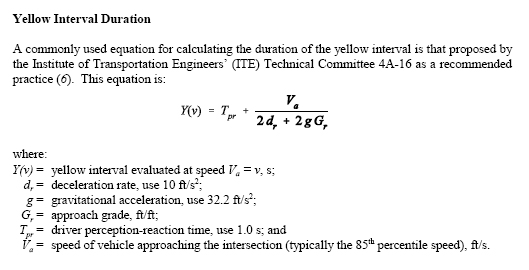Yellow Light Time Standards
Legislation mandating proper yellow light times is mostly non-existent. It is one of the goals of this project to establish national standards to protect motorists.
For the purposes of this project, we have put together a general guide to appropriate yellow light durations.
This guide is intended to help identify potentially dangerous short yellow light times. Whenever possible, suspicious timings will be confirmed by a trained, objective traffic engineer.
Minimum Yellow Light Times
The following table of actual vehicle approach speed vs. minimum yellow light times is a result of calculating the yellow interval duration per the ITE-proposed formula (shown in the next section of this page) and rounding up the result to the nearest half second. These yellow light times are not statutory requirements that can be used as a defense in a court of law. But they do provide a rule-of-thumb when initially evaluating whether a traffic signal's yellow light timing is possibly deficient. Note that these intervals are for normal passenger cars traveling in through, i.e., non-turning, lanes. They are not adequate for turn lanes or special cases such as heavy trucks or buses.
The Federal Highway Administration's Manual on Uniform Traffic Control Devices provides guidance that the yellow interval be between three and six seconds without tying the requirement to specific approach velocities. That said, anything falling below the yellow times shown here should be considered as a potential short yellow light.
25 MPH -- 3.0 Seconds
30 MPH -- 3.5 Seconds
35 MPH -- 4.0 Seconds
40 MPH -- 4.5 Seconds
45 MPH -- 5.0 Seconds
50 MPH -- 5.5 Seconds
55 MPH -- 6.0 Seconds
The following kinematic formula provides a more specific basis for determining the minimum yellow light interval of a traffic signal. While it too does not constitute a legal requirement in many states, the kinematic formula is used by many in the traffic engineering community to establish a baseline for yellow light timing.


